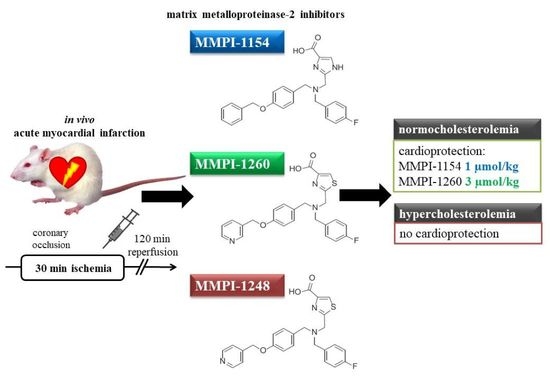Cardioprotective Effect of Novel Matrix Metalloproteinase Inhibitors
Abstract
1. Introduction
2. Results
2.1. Testing the Cardioprotective Effects of Different Doses of MMP Inhibitor Compounds against AMI in Normocholesterolemic Rats
2.1.1. Tolerability of MMP Inhibitors
2.1.2. All-Cause Mortality
2.1.3. Infarct Size
2.1.4. Incidence of Severe Arrhythmias
2.2. Testing the Cardioprotective Effects of Single Dose of MMP Inhibitor Compounds against AMI in Hypercholesterolemia (Hchol) and Age-Matched Normocholesterolemic (Nchol) Rats
2.2.1. Hypercholesterolemic Model Validation
2.2.2. All-Cause Mortality
2.2.3. Infarct Size
2.2.4. MMP-2 and MMP-9 Activities
2.2.5. Microvascular Obstruction
2.2.6. Incidence of Severe Arrhythmias
2.3. Hemodynamics
3. Discussion
3.1. Future Perspectives
3.2. Limitations of the Present Study
4. Materials and Methods
4.1. Animals
4.2. Experimental Model of Acute Myocardial Infarction
4.3. Tolerability Testing
4.4. Animal Models and Treatments
4.5. Determination of Myocardial Infarct Size
4.6. Microvascular Obstruction
4.7. Gelatin Zymography
4.8. Lipid Panel Measurement
4.9. Statistical Analysis
5. Conclusions
6. Patents
Supplementary Materials
Author Contributions
Funding
Acknowledgments
Conflicts of Interest
Abbreviations
| MMP | Matrix metalloproteinase |
| MMPI | Matrix metalloproteinase inhibitor |
| AMI | Acute myocardial infarction |
| IPC | Ischemic preconditioning |
| MVO | microvascular obstruction |
| I/R | Ischemia/reperfusion |
References
- Ibanez, B.; James, S.; Agewall, S.; Antunes, M.J.; Bucciarelli-Ducci, C.; Bueno, H.; Caforio, A.L.P.; Crea, F.; Goudevenos, J.A.; Halvorsen, S.; et al. 2017 ESC Guidelines for the management of acute myocardial infarction in patients presenting with ST-segment elevation: The Task Force for the management of acute myocardial infarction in patients presenting with ST-segment elevation of the European Society of Cardiology (ESC). Eur. Heart J. 2018, 39, 119–177. [Google Scholar] [PubMed]
- Schreckenberg, R.; Klein, J.; Kutsche, H.S.; Schulz, R.; Gomori, K.; Bencsik, P.; Benczik, B.; Agg, B.; Saghy, E.; Ferdinandy, P.; et al. Ischaemic post-conditioning in rats: Responder and non-responder differ in transcriptome of mitochondrial proteins. J. Cell. Mol. Med. 2020, 24, 5528–5541. [Google Scholar] [CrossRef] [PubMed]
- Botker, H.E.; Hausenloy, D.; Andreadou, I.; Antonucci, S.; Boengler, K.; Davidson, S.M.; Deshwal, S.; Devaux, Y.; Di Lisa, F.; Di Sante, M.; et al. Practical guidelines for rigor and reproducibility in preclinical and clinical studies on cardioprotection. Basic Res. Cardiol. 2018, 113, 39. [Google Scholar] [CrossRef] [PubMed]
- Ferdinandy, P.; Hausenloy, D.J.; Heusch, G.; Baxter, G.F.; Schulz, R. Interaction of risk factors, comorbidities, and comedications with ischemia/reperfusion injury and cardioprotection by preconditioning, postconditioning, and remote conditioning. Pharmacol. Rev. 2014, 66, 1142–1174. [Google Scholar] [CrossRef] [PubMed]
- Davidson, S.M.; Ferdinandy, P.; Andreadou, I.; Botker, H.E.; Heusch, G.; Ibanez, B.; Ovize, M.; Schulz, R.; Yellon, D.M.; Hausenloy, D.J.; et al. Multitarget Strategies to Reduce Myocardial Ischemia/Reperfusion Injury: JACC Review Topic of the Week. J. Am. Coll. Cardiol. 2019, 73, 89–99. [Google Scholar] [CrossRef] [PubMed]
- Hausenloy, D.J.; Garcia-Dorado, D.; Botker, H.E.; Davidson, S.M.; Downey, J.; Engel, F.B.; Jennings, R.; Lecour, S.; Leor, J.; Madonna, R.; et al. Novel targets and future strategies for acute cardioprotection: Position Paper of the European Society of Cardiology Working Group on Cellular Biology of the Heart. Cardiovasc. Res. 2017, 113, 564–585. [Google Scholar] [CrossRef] [PubMed]
- Ibrahim, M.A.; Jialal, I. Hypercholesterolemia; StatPearls: Treasure Island, FL, USA, 2020. [Google Scholar]
- Andreadou, I.; Iliodromitis, E.K.; Lazou, A.; Gorbe, A.; Giricz, Z.; Schulz, R.; Ferdinandy, P. Effect of hypercholesterolaemia on myocardial function, ischaemia-reperfusion injury and cardioprotection by preconditioning, postconditioning and remote conditioning. Br. J. Pharmacol. 2017, 174, 1555–1569. [Google Scholar] [CrossRef] [PubMed]
- Makkos, A.; Szantai, A.; Paloczi, J.; Pipis, J.; Kiss, B.; Poggi, P.; Ferdinandy, P.; Chatgilialoglu, A.; Gorbe, A. A Comorbidity Model of Myocardial Ischemia/Reperfusion Injury and Hypercholesterolemia in Rat Cardiac Myocyte Cultures. Front. Physiol. 2019, 10, 1564. [Google Scholar] [CrossRef] [PubMed]
- Giricz, Z.; Lalu, M.M.; Csonka, C.; Bencsik, P.; Schulz, R.; Ferdinandy, P. Hyperlipidemia attenuates the infarct size-limiting effect of ischemic preconditioning: Role of matrix metalloproteinase-2 inhibition. J. Pharmacol. Exp. Ther. 2006, 316, 154–161. [Google Scholar] [CrossRef]
- Kandasamy, A.D.; Chow, A.K.; Ali, M.A.; Schulz, R. Matrix metalloproteinase-2 and myocardial oxidative stress injury: Beyond the matrix. Cardiovasc. Res. 2010, 85, 413–423. [Google Scholar] [CrossRef]
- Chow, A.K.; Cena, J.; Schulz, R. Acute actions and novel targets of matrix metalloproteinases in the heart and vasculature. Br. J. Pharmacol. 2007, 152, 189–205. [Google Scholar] [CrossRef] [PubMed]
- Zavadzkas, J.A.; Mukherjee, R.; Rivers, W.T.; Patel, R.K.; Meyer, E.C.; Black, L.E.; McKinney, R.A.; Oelsen, J.M.; Stroud, R.E.; Spinale, F.G. Direct regulation of membrane type 1 matrix metalloproteinase following myocardial infarction causes changes in survival, cardiac function, and remodeling. Am. J. Physiol. Heart Circ. Physiol. 2011, 301, H1656–H1666. [Google Scholar] [CrossRef] [PubMed]
- Cheung, P.Y.; Sawicki, G.; Wozniak, M.; Wang, W.; Radomski, M.W.; Schulz, R. Matrix metalloproteinase-2 contributes to ischemia-reperfusion injury in the heart. Circulation 2000, 101, 1833–1839. [Google Scholar] [CrossRef]
- DeCoux, A.; Lindsey, M.L.; Villarreal, F.; Garcia, R.A.; Schulz, R. Myocardial matrix metalloproteinase-2: Inside out and upside down. J. Mol. Cell. Cardiol. 2014, 77, 64–72. [Google Scholar] [CrossRef] [PubMed]
- Wang, W.; Schulze, C.J.; Suarez-Pinzon, W.L.; Dyck, J.R.; Sawicki, G.; Schulz, R. Intracellular action of matrix metalloproteinase-2 accounts for acute myocardial ischemia and reperfusion injury. Circulation 2002, 106, 1543–1549. [Google Scholar] [CrossRef]
- Van Eyk, J.E.; Powers, F.; Law, W.; Larue, C.; Hodges, R.S.; Solaro, R.J. Breakdown and release of myofilament proteins during ischemia and ischemia/reperfusion in rat hearts: Identification of degradation products and effects on the pCa-force relation. Circ. Res. 1998, 82, 261–271. [Google Scholar] [CrossRef]
- Sawicki, G.; Leon, H.; Sawicka, J.; Sariahmetoglu, M.; Schulze, C.J.; Scott, P.G.; Szczesna-Cordary, D.; Schulz, R. Degradation of myosin light chain in isolated rat hearts subjected to ischemia-reperfusion injury: A new intracellular target for matrix metalloproteinase-2. Circulation 2005, 112, 544–552. [Google Scholar] [CrossRef]
- Rao, B.G. Recent developments in the design of specific Matrix Metalloproteinase inhibitors aided by structural and computational studies. Curr. Pharm. Des. 2005, 11, 295–322. [Google Scholar] [CrossRef]
- Jacobsen, J.A.; Major Jourden, J.L.; Miller, M.T.; Cohen, S.M. To bind zinc or not to bind zinc: An examination of innovative approaches to improved metalloproteinase inhibition. Biochim. Biophys. Acta 2010, 1803, 72–94. [Google Scholar] [CrossRef]
- Bell, R.M.; Kunuthur, S.P.; Hendry, C.; Bruce-Hickman, D.; Davidson, S.; Yellon, D.M. Matrix metalloproteinase inhibition protects CyPD knockout mice independently of RISK/mPTP signalling: A parallel pathway to protection. Basic Res. Cardiol. 2013, 108, 331. [Google Scholar] [CrossRef]
- Bencsik, P.; Paloczi, J.; Kocsis, G.F.; Pipis, J.; Belecz, I.; Varga, Z.V.; Csonka, C.; Gorbe, A.; Csont, T.; Ferdinandy, P. Moderate inhibition of myocardial matrix metalloproteinase-2 by ilomastat is cardioprotective. Pharmacol. Res. 2014, 80, 36–42. [Google Scholar] [CrossRef] [PubMed]
- Dorman, G.; Cseh, S.; Hajdu, I.; Barna, L.; Konya, D.; Kupai, K.; Kovacs, L.; Ferdinandy, P. Matrix metalloproteinase inhibitors: A critical appraisal of design principles and proposed therapeutic utility. Drugs 2010, 70, 949–964. [Google Scholar] [CrossRef] [PubMed]
- Hudson, M.P.; Armstrong, P.W.; Ruzyllo, W.; Brum, J.; Cusmano, L.; Krzeski, P.; Lyon, R.; Quinones, M.; Theroux, P.; Sydlowski, D.; et al. Effects of selective matrix metalloproteinase inhibitor (PG-116800) to prevent ventricular remodeling after myocardial infarction: Results of the PREMIER (Prevention of Myocardial Infarction Early Remodeling) trial. J. Am. Coll. Cardiol. 2006, 48, 15–20. [Google Scholar] [CrossRef] [PubMed]
- Cerisano, G.; Buonamici, P.; Gori, A.M.; Valenti, R.; Sciagra, R.; Giusti, B.; Sereni, A.; Raspanti, S.; Colonna, P.; Gensini, G.F.; et al. Matrix metalloproteinases and their tissue inhibitor after reperfused ST-elevation myocardial infarction treated with doxycycline. Insights from the TIPTOP trial. Int. J. Cardiol. 2015, 197, 147–153. [Google Scholar] [CrossRef] [PubMed]
- Spaulding, K.; Takaba, K.; Collins, A.; Faraji, F.; Wang, G.; Aguayo, E.; Ge, L.; Saloner, D.; Wallace, A.W.; Baker, A.J.; et al. Short term doxycycline treatment induces sustained improvement in myocardial infarction border zone contractility. PLoS ONE 2018, 13, e0192720. [Google Scholar] [CrossRef]
- Bencsik, P.; Kupai, K.; Gorbe, A.; Kenyeres, E.; Varga, Z.V.; Paloczi, J.; Gaspar, R.; Kovacs, L.; Weber, L.; Takacs, F.; et al. Development of Matrix Metalloproteinase-2 Inhibitors for Cardioprotection. Front. Pharmacol. 2018, 9, 296. [Google Scholar] [CrossRef]
- Montaguti, P.; Melloni, E.; Cavalletti, E. Acute intravenous toxicity of dimethyl sulfoxide, polyethylene glycol 400, dimethylformamide, absolute ethanol, and benzyl alcohol in inbred mouse strains. Arzneimittelforschung 1994, 44, 566–570. [Google Scholar]
- Gad, S.C.; Cassidy, C.D.; Aubert, N.; Spainhour, B.; Robbe, H. Nonclinical vehicle use in studies by multiple routes in multiple species. Int. J. Toxicol. 2006, 25, 499–521. [Google Scholar] [CrossRef]
- Gao, L.; Zheng, Y.J.; Gu, S.S.; Tan, J.L.; Paul, C.; Wang, Y.G.; Yang, H.T. Degradation of cardiac myosin light chain kinase by matrix metalloproteinase-2 contributes to myocardial contractile dysfunction during ischemia/reperfusion. J. Mol. Cell. Cardiol. 2014, 77, 102–112. [Google Scholar] [CrossRef]
- Ali, M.A.; Cho, W.J.; Hudson, B.; Kassiri, Z.; Granzier, H.; Schulz, R. Titin is a target of matrix metalloproteinase-2: Implications in myocardial ischemia/reperfusion injury. Circulation 2010, 122, 2039–2047. [Google Scholar] [CrossRef]
- Roczkowsky, A.; Chan, B.Y.H.; Lee, T.Y.T.; Mahmud, Z.; Hartley, B.; Julien, O.; Armanious, G.; Young, H.S.; Schulz, R. Myocardial MMP-2 contributes to SERCA2a proteolysis during cardiac ischaemia-reperfusion injury. Cardiovasc. Res. 2020, 116, 1021–1031. [Google Scholar] [CrossRef] [PubMed]
- Chan, B.Y.H.; Roczkowsky, A.; Cho, W.J.; Poirier, M.; Lee, T.Y.T.; Mahmud, Z.; Schulz, R. Junctophilin-2 is a target of matrix metalloproteinase-2 in myocardial ischemia-reperfusion injury. Basic Res. Cardiol. 2019, 114, 42. [Google Scholar] [CrossRef] [PubMed]
- Schulz, R. Intracellular targets of matrix metalloproteinase-2 in cardiac disease: Rationale and therapeutic approaches. Annu. Rev. Pharmacol. Toxicol. 2007, 47, 211–242. [Google Scholar] [CrossRef] [PubMed]
- Hughes, B.G.; Schulz, R. Targeting MMP-2 to treat ischemic heart injury. Basic Res. Cardiol. 2014, 109, 424. [Google Scholar] [CrossRef]
- Hutchinson, J.W.; Tierney, G.M.; Parsons, S.L.; Davis, T.R. Dupuytren’s disease and frozen shoulder induced by treatment with a matrix metalloproteinase inhibitor. J. Bone Jt. Surg. Br. 1998, 80, 907–908. [Google Scholar] [CrossRef]
- Baghirova, S.; Hughes, B.G.; Poirier, M.; Kondo, M.Y.; Schulz, R. Nuclear matrix metalloproteinase-2 in the cardiomyocyte and the ischemic-reperfused heart. J. Mol. Cell. Cardiol. 2016, 94, 153–161. [Google Scholar] [CrossRef]
- Cathcart, J.M.; Cao, J. MMP Inhibitors: Past, present and future. Front. Biosci. (Landmark Ed.) 2015, 20, 1164–1178. [Google Scholar]
- Griffin, M.O.; Jinno, M.; Miles, L.A.; Villarreal, F.J. Reduction of myocardial infarct size by doxycycline: A role for plasmin inhibition. Mol. Cell. Biochem. 2005, 270, 1–11. [Google Scholar] [CrossRef]
- Romero-Perez, D.; Fricovsky, E.; Yamasaki, K.G.; Griffin, M.; Barraza-Hidalgo, M.; Dillmann, W.; Villarreal, F. Cardiac uptake of minocycline and mechanisms for in vivo cardioprotection. J. Am. Coll. Cardiol. 2008, 52, 1086–1094. [Google Scholar] [CrossRef]
- Rossello, A.; Nuti, E.; Orlandini, E.; Carelli, P.; Rapposelli, S.; Macchia, M.; Minutolo, F.; Carbonaro, L.; Albini, A.; Benelli, R.; et al. New N-arylsulfonyl-N-alkoxyaminoacetohydroxamic acids as selective inhibitors of gelatinase A (MMP-2). Bioorg. Med. Chem. 2004, 12, 2441–2450. [Google Scholar] [CrossRef]
- Bencsik, P.; Sasi, V.; Kiss, K.; Kupai, K.; Kolossvary, M.; Maurovich-Horvat, P.; Csont, T.; Ungi, I.; Merkely, B.; Ferdinandy, P. Serum lipids and cardiac function correlate with nitrotyrosine and MMP activity in coronary artery disease patients. Eur. J. Clin. Investig. 2015, 45, 692–701. [Google Scholar] [CrossRef] [PubMed]
- D’Annunzio, V.; Donato, M.; Erni, L.; Miksztowicz, V.; Buchholz, B.; Carrion, C.L.; Schreier, L.; Wikinski, R.; Gelpi, R.J.; Berg, G.; et al. Rosuvastatin given during reperfusion decreases infarct size and inhibits matrix metalloproteinase-2 activity in normocholesterolemic and hypercholesterolemic rabbits. J. Cardiovasc. Pharmacol. 2009, 53, 137–144. [Google Scholar] [CrossRef] [PubMed]
- Jung, J.J.; Razavian, M.; Kim, H.Y.; Ye, Y.; Golestani, R.; Toczek, J.; Zhang, J.; Sadeghi, M.M. Matrix metalloproteinase inhibitor, doxycycline and progression of calcific aortic valve disease in hyperlipidemic mice. Sci. Rep. 2016, 6, 32659. [Google Scholar] [CrossRef] [PubMed]
- Botker, H.E.; Lassen, T.R.; Jespersen, N.R. Clinical translation of myocardial conditioning. Am. J. Physiol. Heart Circ. Physiol. 2018, 314, H1225–H1252. [Google Scholar] [CrossRef] [PubMed]
- Inserte, J.; Aluja, D.; Barba, I.; Ruiz-Meana, M.; Miro, E.; Poncelas, M.; Vilardosa, U.; Castellano, J.; Garcia-Dorado, D. High-fat diet improves tolerance to myocardial ischemia by delaying normalization of intracellular PH at reperfusion. J. Mol. Cell. Cardiol. 2019, 133, 164–173. [Google Scholar] [CrossRef]
- Kloner, R.A.; King, K.S.; Harrington, M.G. No-reflow phenomenon in the heart and brain. Am. J. Physiol. Heart Circ. Physiol. 2018, 315, H550–H562. [Google Scholar] [CrossRef]
- Niccoli, G.; Scalone, G.; Lerman, A.; Crea, F. Coronary microvascular obstruction in acute myocardial infarction. Eur. Heart J. 2016, 37, 1024–1033. [Google Scholar] [CrossRef]
- Heusch, G.; Skyschally, A.; Kleinbongard, P. Coronary microembolization and microvascular dysfunction. Int. J. Cardiol. 2018, 258, 17–23. [Google Scholar] [CrossRef]
- Baranyai, T.; Giricz, Z.; Varga, Z.V.; Koncsos, G.; Lukovic, D.; Makkos, A.; Sarkozy, M.; Pavo, N.; Jakab, A.; Czimbalmos, C.; et al. In vivo MRI and ex vivo histological assessment of the cardioprotection induced by ischemic preconditioning, postconditioning and remote conditioning in a closed-chest porcine model of reperfused acute myocardial infarction: Importance of microvasculature. J. Transl. Med. 2017, 15, 67. [Google Scholar] [CrossRef]
- Kiss, K.; Csonka, C.; Paloczi, J.; Pipis, J.; Gorbe, A.; Kocsis, G.F.; Murlasits, Z.; Sarkozy, M.; Szucs, G.; Holmes, C.P.; et al. Novel, selective EPO receptor ligands lacking erythropoietic activity reduce infarct size in acute myocardial infarction in rats. Pharmacol. Res. 2016, 113 Pt A, 62–70. [Google Scholar] [CrossRef]
- Csonka, C.; Kupai, K.; Kocsis, G.F.; Novak, G.; Fekete, V.; Bencsik, P.; Csont, T.; Ferdinandy, P. Measurement of myocardial infarct size in preclinical studies. J. Pharmacol. Toxicol. Methods 2010, 61, 163–170. [Google Scholar] [CrossRef] [PubMed]
- Bonanad, C.; Ruiz-Sauri, A.; Forteza, M.J.; Chaustre, F.; Minana, G.; Gomez, C.; Diaz, A.; Noguera, I.; de Dios, E.; Nunez, J.; et al. Microvascular obstruction in the right ventricle in reperfused anterior myocardial infarction. Macroscopic and pathologic evidence in a swine model. Thromb. Res. 2013, 132, 592–598. [Google Scholar] [CrossRef] [PubMed]
- Bencsik, P.; Bartekova, M.; Gorbe, A.; Kiss, K.; Paloczi, J.; Radosinska, J.; Szucs, G.; Ferdinandy, P. MMP Activity Detection in Zymograms. Methods Mol. Biol. 2017, 1626, 53–70. [Google Scholar]
- Csont, T.; Sarkozy, M.; Szucs, G.; Szucs, C.; Barkanyi, J.; Bencsik, P.; Gaspar, R.; Foldesi, I.; Csonka, C.; Konya, C.; et al. Effect of a multivitamin preparation supplemented with phytosterol on serum lipids and infarct size in rats fed with normal and high cholesterol diet. Lipids Health Dis. 2013, 12, 138. [Google Scholar] [CrossRef] [PubMed]

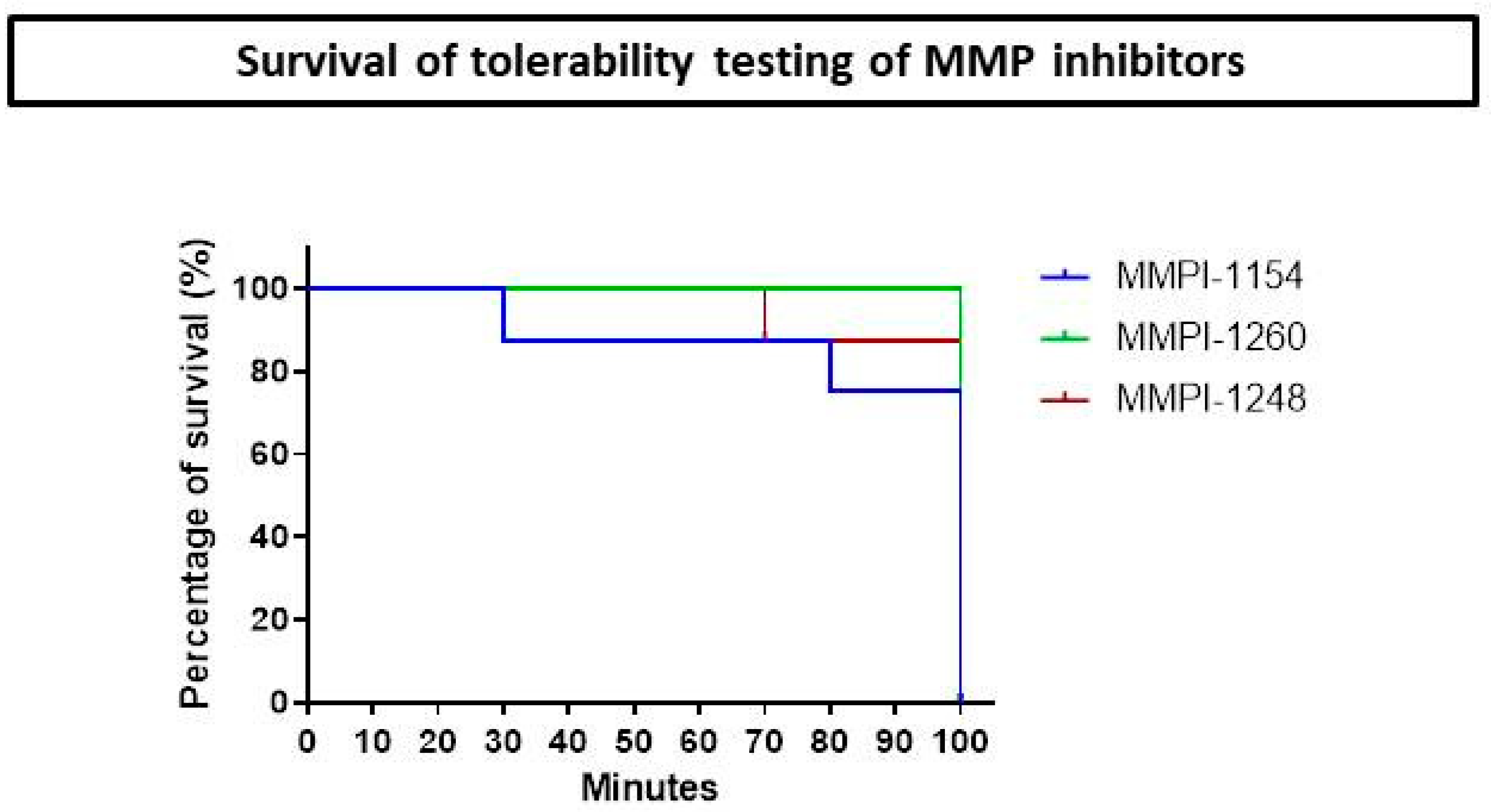
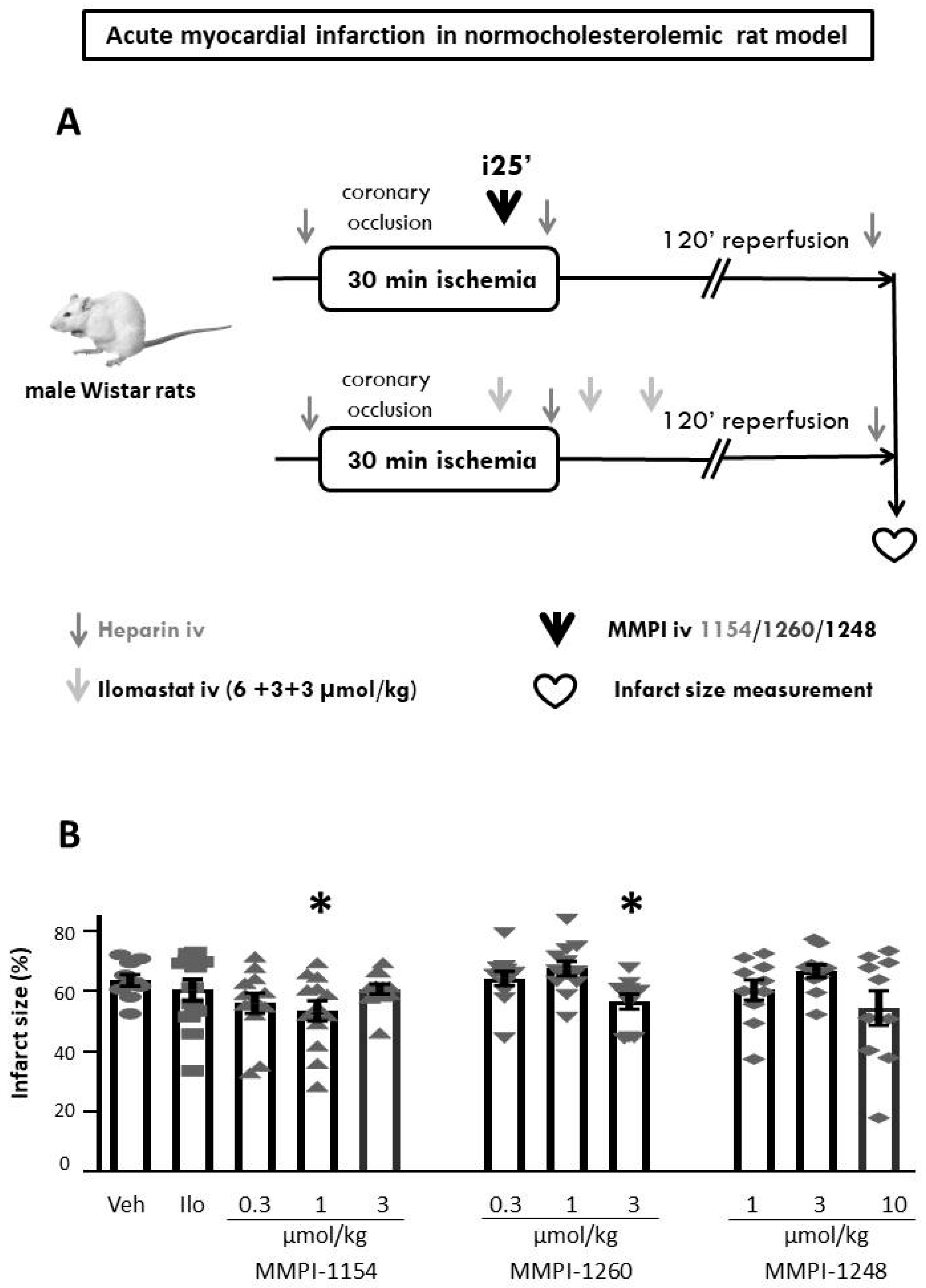
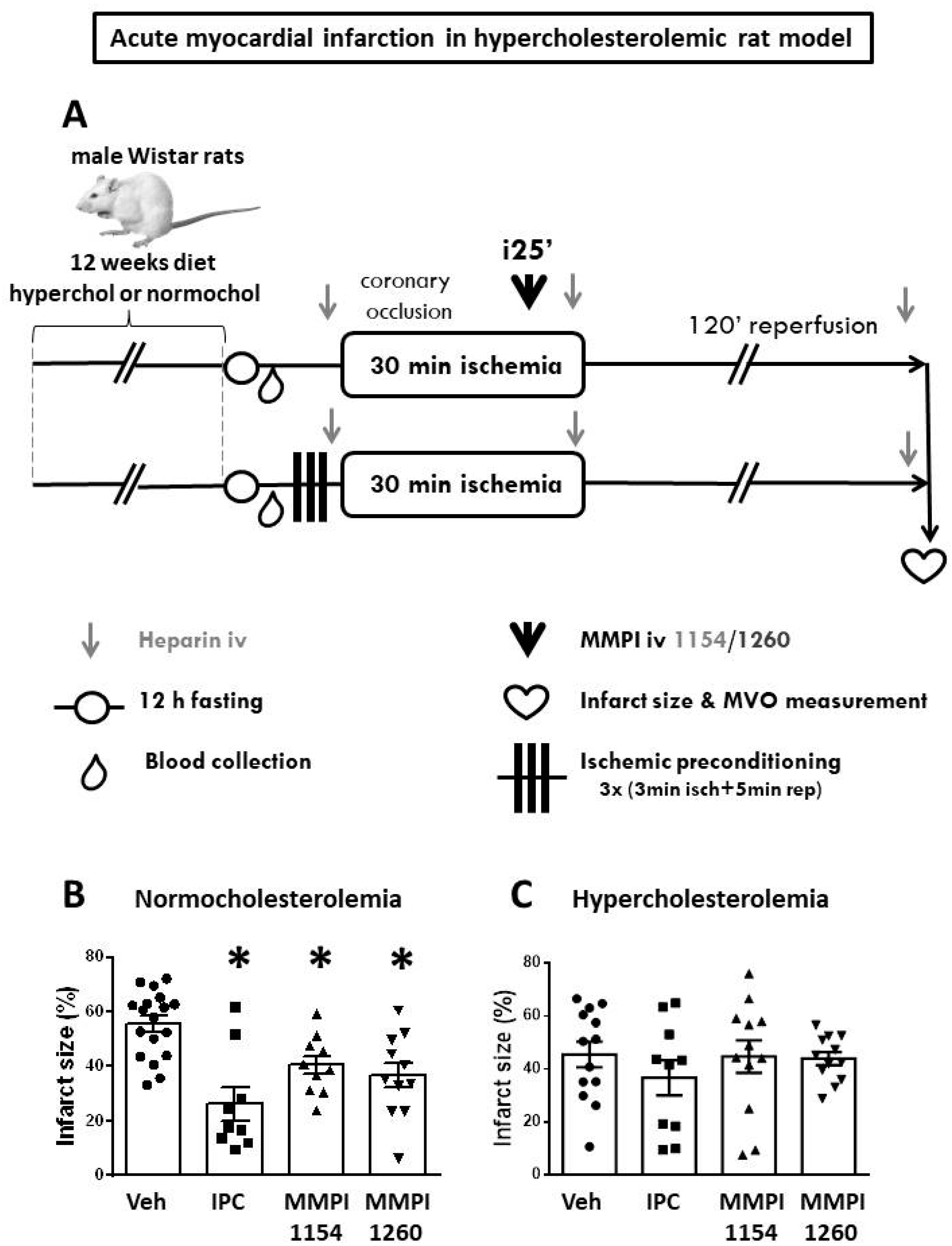
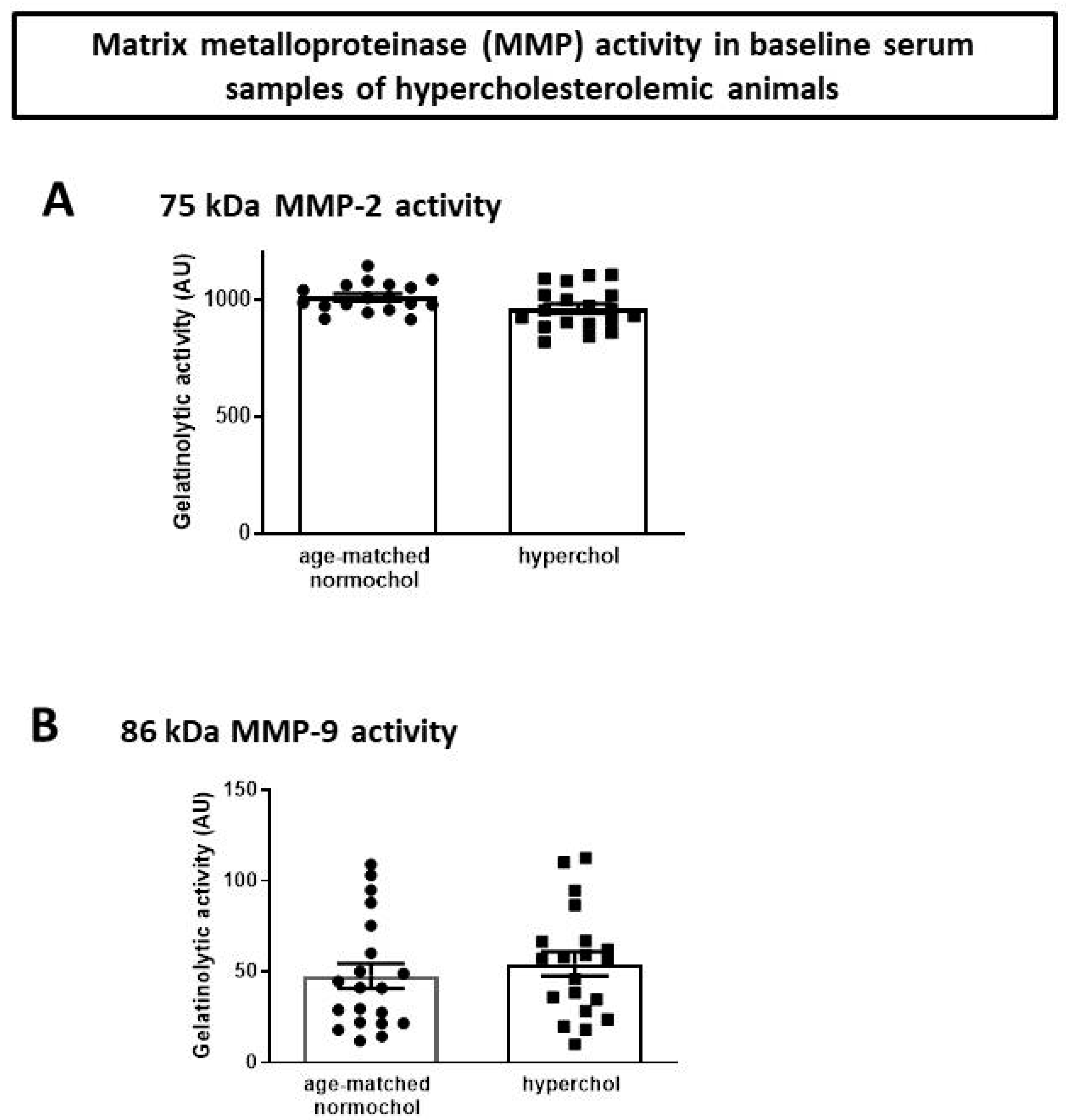
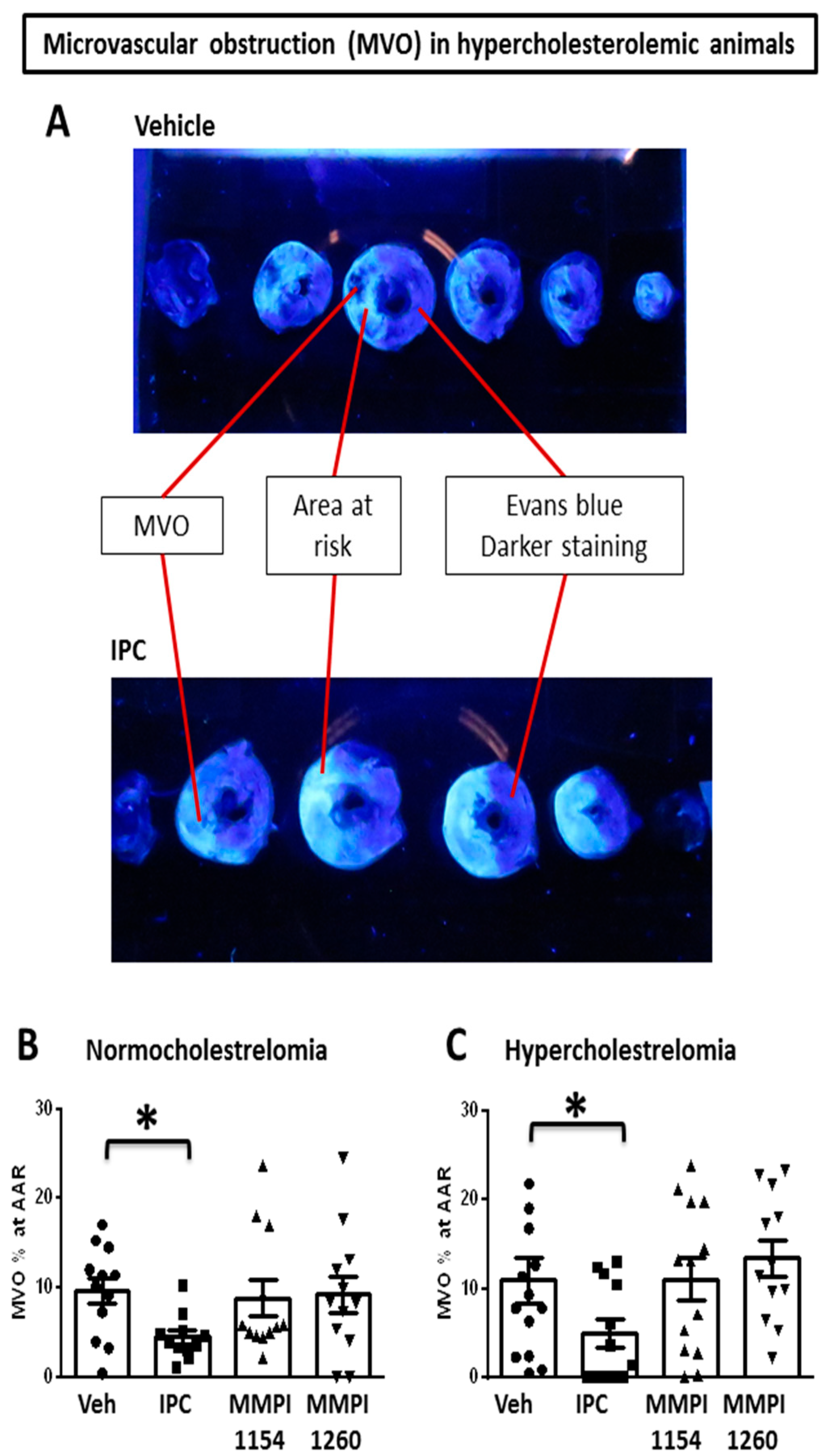
| 0.1 µmol/kg | 0.3 µmol/kg | 1 µmol/kg | 3 µmol/kg | 10 µmol/kg | ||||||||
|---|---|---|---|---|---|---|---|---|---|---|---|---|
| MABP | Baseline | 0′ | 10′ | 20′ | 30′ | 40′ | 50′ | 60′ | 70′ | 80′ | 90′ | 100′ |
| Vehicle | 132 ± 10 | 129 ± 15 | 120 ± 12 | 113 ± 13 | 113 ± 11 | 120 ± 12 | 112 ± 13 | 117 ± 11 | 107 ± 11 | 110 ± 10 | 113 ± 9 | 113 ± 7 |
| MMPI-1154 | 151 ± 8 | 146 ± 7 | 133 ± 7 | 134 ± 8 | 138 ± 6 | 133 ± 8 | 140 ± 7 | 137 ± 7 | 124 ± 12 | 128 ± 5 | 134 ± 6 | 137 ± 7 |
| MMPI-1260 | 138 ± 8 | 137 ± 8 | 121 ± 13 | 120 ± 18 | 123 ± 14 | 114 ± 15 | 122 ± 11 | 119 ± 12 | 116 ± 11 | 123 ± 10 | 126 ± 10 | 129 ± 10 |
| MMPI-1248 | 105 ± 8 | 98 ± 8 | 103 ± 9 | 99 ± 8 | 90 ± 9 | 82 ± 7 | 88 ± 13 | 91 ± 10 | 89 ± 14 | 79 ± 11 | 110 ± 11 | 99 ± 9 |
| 0.1 µmol/kg | 0.3 µmol/kg | 1 µmol/kg | 3 µmol/kg | 10 µmol/kg | ||||||||
|---|---|---|---|---|---|---|---|---|---|---|---|---|
| HR | Baseline | 0′ | 10′ | 20′ | 30′ | 40′ | 50′ | 60′ | 70′ | 80′ | 90′ | 100′ |
| Vehicle | 425 ± 15 | 412 ± 14 | 418 ± 6 | 389 ± 9 | 405 ± 8 | 397 ± 10 | 379 ± 9 | 384 ± 6 | 387 ± 12 | 378 ± 8 | 376 ± 16 | 385 ± 17 |
| MMPI-1154 | 436 ± 16 | 444 ± 12 | 403 ± 18 | 411 ± 19 | 411 ± 8 | 438 ± 10 | 393 ± 15 | 413 ± 14 | 389 ± 15 | 405 ± 17 | 390 ± 9 | 406 ± 15 |
| MMPI-1260 | 435 ± 5 | 439 ± 4 | 422 ± 8 | 432 ± 15 | 417 ± 12 | 428 ± 6 | 413 ± 8 | 416 ± 12 | 411 ± 13 | 420 ± 12 | 413 ± 10 | 416 ± 10 |
| MMPI-1248 | 440 ± 9 | 446 ± 11 | 417 ± 11 | 427 ± 17 | 400 ± 13 | 380 ± 21 | 386 ± 14 | 403 ± 18 | 377 ± 32 | 373 ± 19 | 384 ± 11 | 385 ± 19 |
© 2020 by the authors. Licensee MDPI, Basel, Switzerland. This article is an open access article distributed under the terms and conditions of the Creative Commons Attribution (CC BY) license (http://creativecommons.org/licenses/by/4.0/).
Share and Cite
Gömöri, K.; Szabados, T.; Kenyeres, É.; Pipis, J.; Földesi, I.; Siska, A.; Dormán, G.; Ferdinandy, P.; Görbe, A.; Bencsik, P. Cardioprotective Effect of Novel Matrix Metalloproteinase Inhibitors. Int. J. Mol. Sci. 2020, 21, 6990. https://doi.org/10.3390/ijms21196990
Gömöri K, Szabados T, Kenyeres É, Pipis J, Földesi I, Siska A, Dormán G, Ferdinandy P, Görbe A, Bencsik P. Cardioprotective Effect of Novel Matrix Metalloproteinase Inhibitors. International Journal of Molecular Sciences. 2020; 21(19):6990. https://doi.org/10.3390/ijms21196990
Chicago/Turabian StyleGömöri, Kamilla, Tamara Szabados, Éva Kenyeres, Judit Pipis, Imre Földesi, Andrea Siska, György Dormán, Péter Ferdinandy, Anikó Görbe, and Péter Bencsik. 2020. "Cardioprotective Effect of Novel Matrix Metalloproteinase Inhibitors" International Journal of Molecular Sciences 21, no. 19: 6990. https://doi.org/10.3390/ijms21196990
APA StyleGömöri, K., Szabados, T., Kenyeres, É., Pipis, J., Földesi, I., Siska, A., Dormán, G., Ferdinandy, P., Görbe, A., & Bencsik, P. (2020). Cardioprotective Effect of Novel Matrix Metalloproteinase Inhibitors. International Journal of Molecular Sciences, 21(19), 6990. https://doi.org/10.3390/ijms21196990





